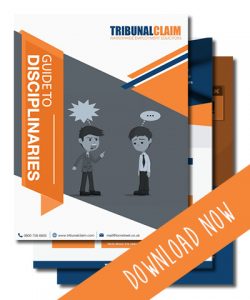Regardless of the severity or otherwise of an employees conduct, employers must follow robust and rigorous disciplinary procedure when disciplining staff. Often no formal action will be required but where the severity of the conduct or the level of capability is such that formal action is required then clear procedures should be followed.
Download our useful guide now.
Step One: The investigation
An employer should carry out a thorough investigation of the problem and invite the employee to an investigation meeting to hear their version of events. Employees are entitled to union representation or to have another colleague accompany them at the investigation meeting.
Step Two: Informing the Employee of Disciplinary Process
The employee should be informed, ideally in writing, that formal action is being considered and given sufficient information about their conduct or poor performance so that they can prepare a case. They should also be informed about the worst possible outcome so that they can gauge the seriousness of the situation that they find themselves in. For example, “If it is decided that you are guilty then this may lead to your employment contract being terminated with immediate effect”.
Step Three: The Disciplinary Hearing
A disciplinary hearing should be arranged and an employee who is facing a formal warning or dismissal should be told that they are entitled to be accompanied to that meeting by a union rep or a colleague. Check your contract or staff handbook as some organisations will allow different categories of people to accompany you. It is not usually possible to ask a person outside the organisation to accompany you such as a spouse, parent or friend. It may be worth asking your employer if it is possible to bring someone different as they may agree.
Step Four: The Outcome
Following the disciplinary hearing and after all the available evidence has been considered, an employee should be given formal notification of the outcome of the disciplinary procedure. This should be in writing and should set out the right to appeal and the process by which an employee can appeal the decision if they disagree with it. In the case of a disciplinary sanction less than dismissal it should be clear how long any conduct might remain on an employees record. If some sort of improvement is sought then the nature of the improvement or any timescales or targets should be given.
What if you cannot attend?
If an employee does not attend a disciplinary hearing then it should be rescheduled but if an employee is unwilling or unable to attend rescheduled meetings even after reasonable efforts have been made to accommodate them then an employer can go through the disciplinary process in their absence based on the evidence that they have.
What if you do not agree with the decision?
Employees have the right to appeal disciplinary decisions that they disagree with. You should check the letter setting out the outcome of the disciplinary process or the staff handbook to find out how to do this. If you can’t find the information that you need then write and set out why you think any sanction taken is incorrect within 7 days of receiving the decision.
———————————————–
Further information on the Disciplinary Process
Resignation during the disciplinary process
External links
Delaying the disciplinary process
Employment rights in disciplinary procedures
Infographic: Misconduct disciplinary procedure – ACAS Code


